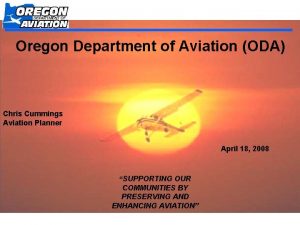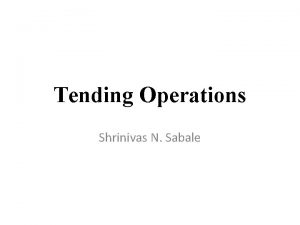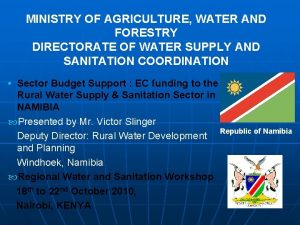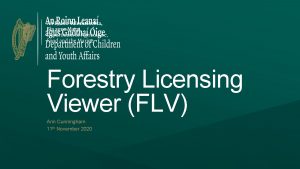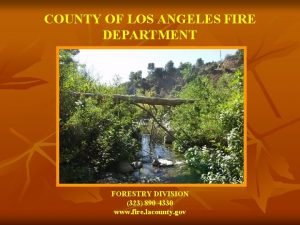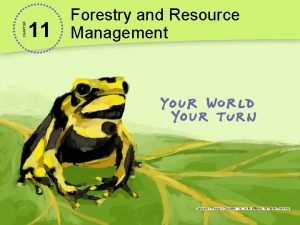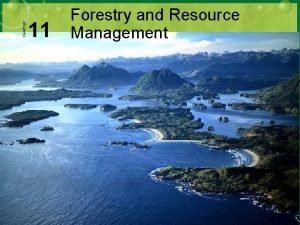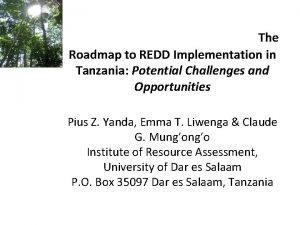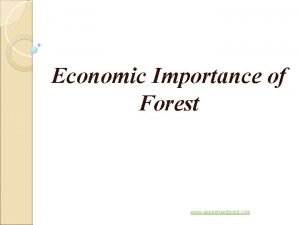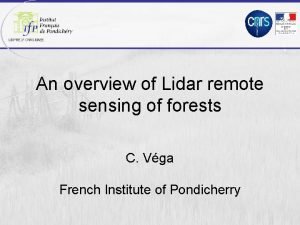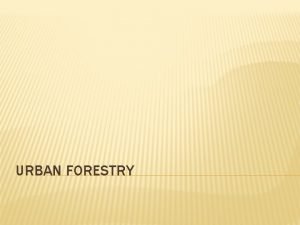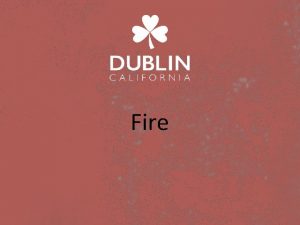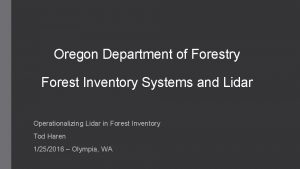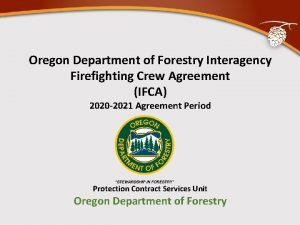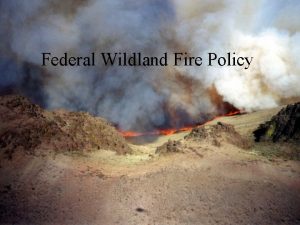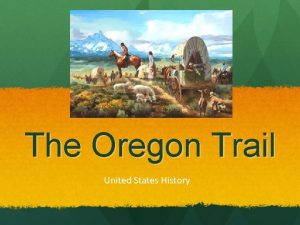Oregon Department of Forestry History Fire Policy Organizational













- Slides: 13

Oregon Department of Forestry Ø History Ø Fire Policy Ø Organizational Structures and Funding ØFinal Thoughts 1

Historical Perspective Ø 1902 - Western Oregon fires - >700, 000 acres Ø 1904 - Company fire patrols formed Ø 1911 -12 - Oregon Fire Laws: Board of Forestry & first State Forester l Ø Francis Elliott $60 K budget 1913 - Compulsory Fire Patrol laws l l Mandated forest a protection system and the suppression of all fires Outlined Landowners’ responsibility § Provide or pay for protection 2

ORS 477. 005 Forest Protection Policy Ø (1) “The preservation of forests & the conservation of the forest resources through the prevention and the suppression of forest fires hereby are declared to be the public policy of the State of Oregon. ” Ø (2) (a) “The need for a Complete and Coordinated Forest Protection System is acknowledged and the primary mission of the State Forestry Department” § Primary Missions/Priorities: Ø Protection of life Ø Protecting forest resources Ø Structural protection shall not inhibit forest resource protection 3

ORS 477. 064 - Uncontrolled Fire declared nuisance Ø “Any fire on any forestland in Oregon burning uncontrolled or without proper action being taken to prevent its spread, not withstanding its origin, is declared a public nuisance by reason of its menace to life, forest resources or property. ” 4

ORS 477. 066 - Duty of owner and operator to abate fire Ø “Each owner and operator of forestland on which a fire exists or from which it may have spread, notwithstanding the origin or subsequent spread thereof, shall immediately proceed to control and extinguish such fire when its existence comes to the knowledge of the owner or operator. ” Ø The state of Oregon policies are clear: Fires shall be extinguished to limit risks to the public and natural resources. (ORS 477. 005 -. 064) State Law. 5

Organizational Structure Ø 3 Main Operating Divisions (Fire, State Forest, and Private Forest) Ø 12 Forest Protection Districts l 3 “Operating” Associations • DFPA, CFPA, Walker Range Ø “Complete & Coordinated System” § § § Member of PNWCG BLM westside contract: 2. 3 million acres A coordination center linked to field dispatch centers (ODF, interagency centers, and NWCC) § 3 IMTs all have been through CIMC § 3 Fire Cache Support Systems 6

What is the landscape? Ø Approximately 32 million of acres of forestland Ø ODF protects approximately half (16 million) l Ø Unique compared to other states in the west. Protection is largely intertwined with hundreds of thousands of miles of boundaries. Ø Coordination and consideration of other agencies is critical. 7

How is the System Financed? Ø Based roughly on a partnership between the state and forest landowners (50: 50) • Clear expectation to limit costs to the state and forestland owners • annually approx. $40 million Ø Large fire funding is shared between State General Fund and Landowners (OFLPF) Ø The State of Oregon is unique in that it carries a $25 million private insurance policy • Annual coverage for large fires is $50 million above the base level of protection Ø State General Fund also has severity funding via ORS 477. 777 - This funds contracted helicopters and ATs 8

Take-home messages Ø Due to funding structures, missions, state laws, and ODF’s relationships with our landowners… l ODF will continue to be engaged with fires on our protection and also fires and management decisions of other landowners l ODF is the private fire department and voice forest landowners We are their only protection insurance policy l Think in terms of your own home and the role of local city or rural fire department l ODF strives to limit damage or loss of resources on lands we protect 9

Take-home messages Ø ODF operators a complete and coordinate protection system funded from limited sources l ODF’s answer : Adequately fund the system to suppress fires at the smallest possible size and limit risk to resources and our firefighters. Ø Fully understand the need to treat fuels, reduce risks and restore ecosystems. l Ø Likely differences occur in timing and methods We firmly believe in a good neighbor policy. l Up-front, clear communication l Management decisions should not impact neighbors l Good relationships are critical 10

The Future and Considerations Ø The key to everyone’s success: Maintain tools and funding to manage forests and restore ecosystems. l Risks • Unclear objectives that are not well understood by the public and policymakers • Public and firefighter safety concerns • Transferring of risks to other agencies and entities • Transferring costs to others • Decisions that put entities in places where support cannot be given - a united voice is always better • Smoke impacts • “Social License” 11

Keys Ø Public understanding and clarity around mission, goals and objectives (sound bites) Ø Internal and External understanding and relationships Ø Communication Ø Coordination of Decision Making Ø Ultimately- the “Social License” to manage and protect public and private resources 12

Input and thoughts Ø How do we resolve or work within federal objectives and policies and state mandates and laws? Ø How do actions of each agency impact objectives and laws? Ø How do agencies limit transferring risk and costs due to management decisions all while meeting objectives? Ø What does being a “good neighbor” mean to folks in the room? Ø How do we collectively as decision makers maintain and enhance the “social license” management concept? 13
 Oviposition
Oviposition Oda
Oda Oregon water resources department
Oregon water resources department Tending operations definition
Tending operations definition Ministry of agriculture, water and forestry directorates
Ministry of agriculture, water and forestry directorates Forestry licence viewer
Forestry licence viewer La county fuel modification
La county fuel modification Forestry and resource management chapter 11 answers
Forestry and resource management chapter 11 answers Forestry and resource management chapter 11 answers
Forestry and resource management chapter 11 answers Forestry io roadmap
Forestry io roadmap Careers related to forestry
Careers related to forestry Mendel university of agriculture and forestry
Mendel university of agriculture and forestry Economic importance of coniferous forest
Economic importance of coniferous forest Lidar remote sensing for forestry
Lidar remote sensing for forestry

